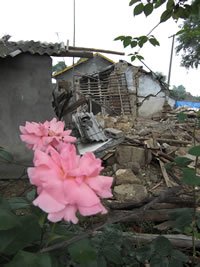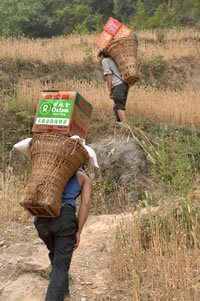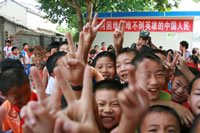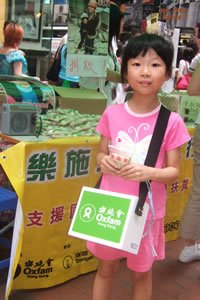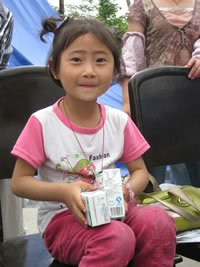By Howard Liu
Oxfam Hong Kong has done all it can to provide relief supplies to as many people affected by the 12 May earthquake as possible. As of 12 June, we assisted over 280,000 people in about 35 different areas of Sichuan, Gansu and Shaanxi, providing counselling for children, public health services for whole communities, and about twenty types of necessities, such as rice, water, milk, medicine, quilts, shelter, and sanitary products, altogether valued at about 17.2 million Yuan. Another 3.6 million Yuan has gone towards the construction of new schools for children, for a total of 20,802,839 Yuan.
Oxfam's relief programme began within an hour or so after the earthquake struck on that Monday afternoon, the birthday of Buddha, a holiday in Hong Kong, when several staff members were in a strategic planning meeting in the office. Decisions were made immediately, an initial HK$12 million was committed (over USD2.5m) and staff members were sent to the site from our offices in Kunming and Lanzhou. The response would be the largest and most challenging relief effort ever undertaken by Oxfam Hong Kong in its 30 years of operation, and yet an even greater challenge is ahead: post-disaster rehabilitation. It is a challenge not only for Oxfam, but also for the Chinese government and other humanitarian agencies.
The situation in Sichuan is more complicated than in sites of previous disasters. The 300 kilometre Wenchuan seismic belt can basically be classified into two types of landscape: undulating areas or plateaus, where more than 30 million people have been affected; and mountainous villages, where some 2 million people have been impacted.
Assisting people in these more remote mountainous areas is the greater challenge, and is Oxfam's priority.
The epicentre of the 8.0 earthquake was located in the Longmen Shan range, where many mountains reach about 2,000 metres high, and seismic activity is also high: in about 50 seconds, the rupture travelled at least 100 kilometres in a northeasterly direction, into Gansu and Shaanxi.
The Longmen Shan area remains at risk over the next three to five years: quake lakes, landslides, and flows of debris. In-situ rehabilitation in the mountains is therefore very problematic, as is a hurried resettlement. Which is best? This is a question that the authorities, the communities, and local and international agencies will need to study in depth. Compensation issues are almost always complicated, and time is needed for negotiation. The sites selected for relocation must have enough farmland, schools, hospitals and other resources to accommodate a sudden influx of displaced people. When ethnic minority peoples, such as Hui (Muslims), Qiang and Tibetans, need to be re-housed, additional considerations must also be taken into account: how to help preserve unique cultural traditions yet also enable people to assimilate into the new, Han-dominated environment.
Participatory community development, a method long advocated by Oxfam in its twenty years of working in Mainland China, will be crucial. Planning and implementing rehabilitation projects in an open and transparent way – in other words, allowing the residents themselves to be involved in decision-making – ensures that decisions are acceptable to as many people as possible.
Public participation usually leads to a faster recovery, better access to information, a more efficient village/town management, more effective monitoring of rehabilitation projects, a more revitalizing redevelopment of local communities, and a fuller recovery from the psychological and emotional trauma of a disaster. This view is more or less shared by the Central Government. The Ministry of Civil Affairs, which leads the government's rehabilitation planning and processes, has indicated that rehabilitation entails more than an appropriate site selection; it also must include a respect for residents' hopes and wishes, as well as their rights to speak out about the process, and to be informed along the way.
It is a long way ahead, a colossal task. Oxfam set up its fifth mainland office in Chengdu on Children's Day, 1 June, to oversee this work over the next three to five years.
'One Month On', an in-depth report issued on 12 June which includes an overview of both the relief work done and the rehabilitation work ahead is available on the agency website
Howard Liu leads Oxfam Hong Kong's earthquake response in Sichuan, Gansu and Shaanxi. He is the Director of Oxfam Hong Kong's China Unit.

